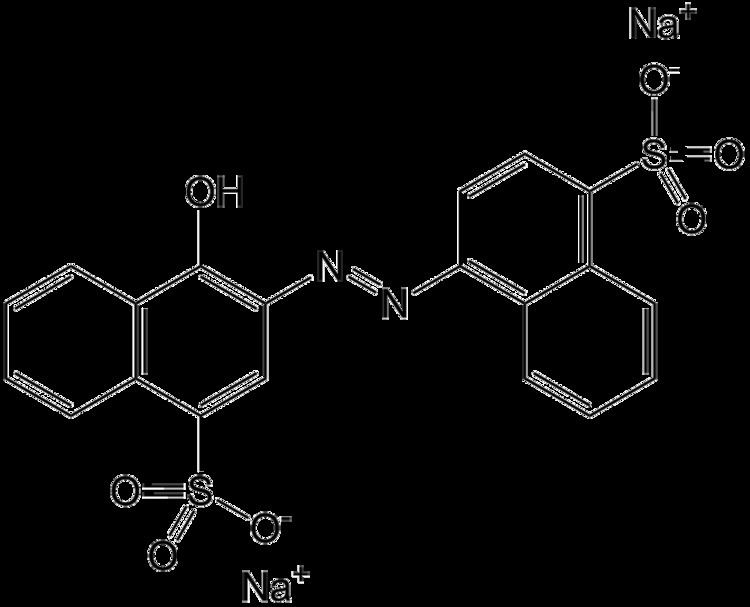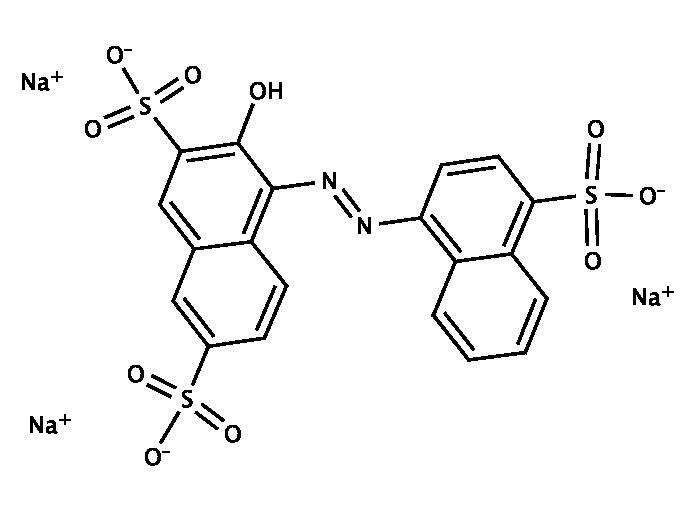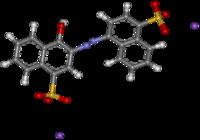Formula C20H12N2Na2O7S2 | Appearance red powder | |
 | ||
Azorubine meaning
Azorubine, carmoisine, Food Red 3, Azorubin S, Brillantcarmoisin O, Acid Red 14, or C.I. 14720 is a synthetic red food dye from the azo dye group. It usually comes as a disodium salt. It is a red to maroon powder. It is used for the purposes where the food is heat-treated after fermentation. It has E number E122.
Contents

What does azorubine mean
Uses

In the US, this color was listed in 1939 as D&C Red No. 10 for use in externally applied drugs and cosmetics. It was delisted in 1963 because no party was interested in supporting the studies needed to establish safety. It was never used in food in the US.

In the EU azorubine is authorized for use in certain foods and beverages, such as cheeses, dried fruit, and some alcoholic beverages, and is permitted for use as an excipient in medications.
There are no provisions for azorubine in the Codex Alimentarius.
Safety

Azorubine has shown no evidence of mutagenic or carcinogenic properties and an acceptable daily intake (ADI) of 0–4 mg/kg was established in 1983 by the WHO.
Possible cause of hyperactivity
Since the 1970s and the well-publicized advocacy of Benjamin Feingold, there has been public concern that food colorings may cause ADHD-like behavior in children. These concerns have led the FDA and other food safety authorities to regularly review the scientific literature, and led the UK FSA to commission a study by researchers at Southampton University of the effect of a mixture of six food dyes (Tartrazine, Allura Red, Ponceau 4R, Quinoline Yellow WS, Sunset Yellow and Carmoisine (dubbed the "Southampton 6") and sodium benzoate (a preservative) on children in the general population, who consumed them in beverages; the study published in 2007. The study found "a possible link between the consumption of these artificial colours and a sodium benzoate preservative and increased hyperactivity" in the children; the advisory committee to the FSA that evaluated the study also determined that because of study limitations, the results could not be extrapolated to the general population, and further testing was recommended".
The European regulatory community, with a stronger emphasis on the precautionary principle, required labelling and temporarily reduced the acceptable daily intake (ADI) for the food colorings; the UK FSA called for voluntary withdrawal of the colorings by food manufacturers. However, in 2009 the EFSA re-evaluated the data at hand and determined that "the available scientific evidence does not substantiate a link between the color additives and behavioral effects".
The US FDA did not make changes following the publication of the Southampton study, but following a citizen petition filed by the Center for Science in the Public Interest in 2008, requesting the FDA ban several food additives, the FDA commenced a review of the available evidence, and still made no changes.
There is no evidence to support broad claims that food coloring causes food intolerance and ADHD-like behavior in children. It is possible that certain food coloring may act as a trigger in those who are genetically predisposed, but the evidence is weak.
